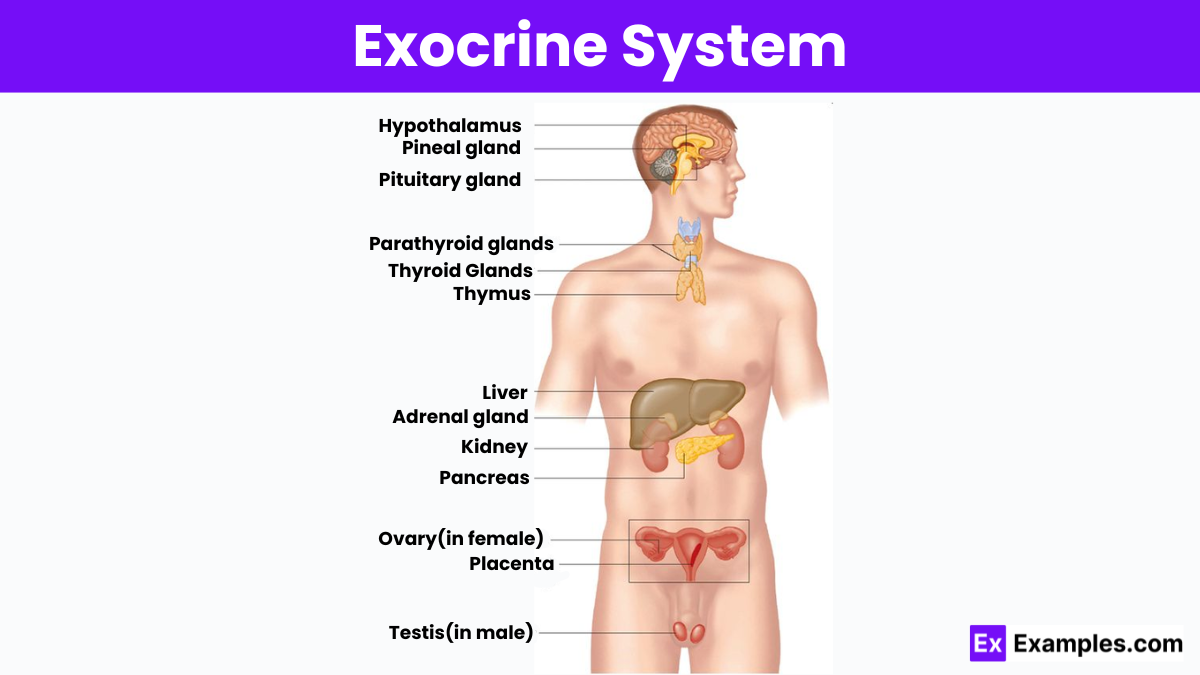Which of the following is an example of an exocrine gland?
Adrenal gland
Thyroid gland
Salivary gland
Pituitary gland


Exocrine glands are key structures that release substances onto epithelial surfaces through ducts. Located throughout the body, these glands include salivary glands producing saliva, sweat glands regulating temperature, and mammary glands secreting milk. Other types include lacrimal glands for tears, sebaceous glands for skin oil, and mucous glands for internal moisture. Notably, the liver and pancreas also serve as exocrine glands by delivering digestive substances into the gastrointestinal tract, alongside their endocrine functions of hormone secretion.
Exocrine glands are specialized units consisting of cells that synthesize and secrete substances through ducts to external or internal body surfaces. These glands play crucial roles in maintaining various physiological processes by releasing a range of substances such as sweat, tears, saliva, milk, and digestive juices. Found throughout the body, exocrine glands are integral to the function of many organs and contribute to homeostasis and overall health.

Exocrine glands vary widely in function and location, demonstrating the complexity and diversity of glandular structures in the human body. Here are some prominent types:
The liver and pancreas also function as exocrine glands, secreting bile and pancreatic juices into the gastrointestinal tract to assist in digestion.
Exocrine glands feature two main parts: the glandular section and the duct section, which serve as the basis for classifying the gland.
We can categorize exocrine glands into three types based on their secretion method: merocrine, apocrine, or holocrine.
Exocrine glands produce a variety of secretions:
Salivary glands are responsible for the production and secretion of saliva, which aids in the initial digestion of food, lubricates the mouth, and helps protect the teeth from decay. The primary salivary glands include the parotid, submandibular, and sublingual glands.
Sweat glands are involved in thermoregulation and excretion and are classified into two types:
Mammary glands, specialized organs in mammals, produce milk to nourish newborns.
Sebaceous glands are typically found in close association with hair follicles and secrete an oily substance called sebum. Sebum helps to lubricate and waterproof the skin and hair, preventing them from becoming dry and brittle.
The pancreas has both exocrine and endocrine functions. The exocrine part produces digestive enzymes, which are secreted into the small intestine to aid in the digestion of food. These enzymes include lipase, amylase, and proteases.
The liver, while primarily known for its metabolic and detoxifying roles, also functions as an exocrine gland through the production of bile. Bile is essential for the digestion and absorption of dietary fats.
Located within the stomach lining, gastric glands secrete gastric juice, which contains hydrochloric acid and digestive enzymes. This secretion is crucial for the digestion of proteins and the killing of bacteria ingested with food.
“Exocrine glands secrete” refers to the function of a type of gland in the body. The term “secrete” means to produce and discharge a substance from cells or glands. So, when we say “exocrine glands secrete,” we mean that these glands produce and release specific substances (such as enzymes, mucus, sweat, saliva, etc.) through ducts to the outside of the body or into body cavities. These secretions play various roles in digestion, lubrication, cooling, protection, and other bodily functions, depending on the type of exocrine gland and its location in the body.

Exocrine glands, crucial for various bodily functions, can be affected by a range of conditions and disorders that impair their ability to function properly. Here’s an overview of common issues associated with different types of exocrine glands:
Endocrine glands secrete hormones directly into the bloodstream, lacking ducts. Exocrine glands release substances via ducts to external or internal surfaces.
Exocrine glands secrete substances like sweat, saliva, and digestive enzymes through ducts to the body’s internal or external surfaces.
The pancreas and liver function as both endocrine and exocrine glands, secreting hormones and digestive juices.
The liver is the largest exocrine gland, producing bile important for digestion.
The three main types of exocrine glands are merocrine, apocrine, and holocrine glands, differing in their methods of secretion.
Text prompt
Add Tone
10 Examples of Public speaking
20 Examples of Gas lighting
Which of the following is an example of an exocrine gland?
Adrenal gland
Thyroid gland
Salivary gland
Pituitary gland
Exocrine glands secrete their products:
Directly into the bloodstream
Into ducts
Into lymphatic vessels
Into the brain
Which of the following is NOT an exocrine gland?
Sweat gland
Mammary gland
Pancreas (exocrine function)
Pineal gland
What type of secretion do sebaceous glands produce?
Saliva
Sweat
Sebum
Enzymes
Which gland has both exocrine and endocrine functions?
Thyroid
Adrenal
Pancreas
Parathyroid
Where are ceruminous glands located?
Scalp
Armpits
Ear canal
Palms
Which type of gland secretes sweat that helps regulate body temperature?
Apocrine glands
Eccrine glands
Sebaceous glands
Ceruminous glands
The primary role of mammary glands is to:
Produce sweat
Secrete digestive enzymes
Produce milk
Secrete hormones
Which exocrine gland secretes digestive enzymes into the small intestine?
Adrenal gland
Thyroid gland
Pancreas
Pituitary gland
Exocrine gland ducts can be classified based on their:
Hormone production
Location in the brain
Blood supply
Shape and branching patterns
Before you leave, take our quick quiz to enhance your learning!

